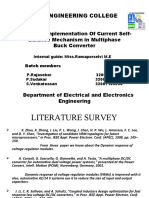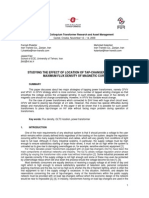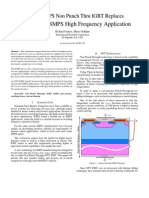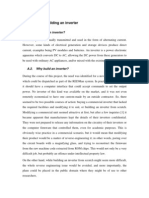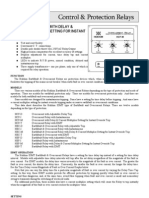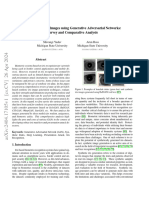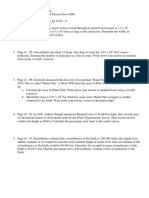Body Effect For Semiconducting ICs
Body Effect For Semiconducting ICs
Uploaded by
Hugo RueschCopyright:
Available Formats
Body Effect For Semiconducting ICs
Body Effect For Semiconducting ICs
Uploaded by
Hugo RueschCopyright
Available Formats
Share this document
Did you find this document useful?
Is this content inappropriate?
Copyright:
Available Formats
Body Effect For Semiconducting ICs
Body Effect For Semiconducting ICs
Uploaded by
Hugo RueschCopyright:
Available Formats
Technology Brief
Body Effect and Body Biasing
The SuVolta Deeply Depleted Channel (DDC) transistor enables more effective threshold voltage management through body biasing, which leads to lower power consumption and higher yields for deep submicron CMOS technologies. There are a variety of body biasing methodologies that take advantage of the unique properties of the DDC transistor. Adaptive body biasing can be used to correct systematic manufacturing variations, thus decreasing V T variation and improving sort yield. Dynamic body biasing can be used to reduce temperature and aging effects as well as to make power management modes more effective at optimizing very low power operation.
suvolta.com
Body Effect:
Body effect refers to the change in the transistor threshold voltage (V T ) resulting from a voltage difference between the transistor source and body. Because the voltage difference between the source and body affects the V T, the body can be thought of as a second gate that helps determine how the transistor turns on and off. The strength of the body effect is usually quantified by the body coefficient gamma. Strong body effect enables a variety of effective body biasing techniques, and these techniques were used effectively in older process generations. However, body effect has diminished with transistor scaling, and conventional deep-submicron transistors have very little body effect. For this reason body bias is not widely used for 65nm and smaller process technologies. Instead, the transistor bodies are generally connected along with the transistor source to either power (VDD) for p-channel or ground (VSS) for n-channel transistor. The SuVolta DDC transistor, on the other hand, has a stronger body effect than conventional transistors and therefore enables effective V T management through body biasing. This strong body effect is a key enabler of low-power circuit operation for deep submicron CMOS technologies.
Body Bias Methodologies:
There are several different body biasing methodologies. The simplest body bias methodology is to apply a fixed body bias voltage identically to all product chips with the body bias value set during design. In a transistor with strong body effect this fixed body bias augments the role of doping in and near the transistor channel in setting the transistor threshold voltage. Power gating transistors provide an interesting opportunity to use a fixed bias: a fixed forward bias is applied during the on state to reduce the on-resistance of the transistor switch; alternatively, a fixed reverse bias is applied during the off state to reduce the remaining leakage in the power-gated block. A more advanced body bias methodology is to apply an adaptive body bias, where for each chip a different fixed body bias value is calibrated at production test. Adaptive body bias is a valuable tool for overcoming systematic manufacturing variation, which is usually manifested in the product as leakage or timing variation between chips. For instance, forward body bias applied to a slow chip lowers the transistor threshold voltage and speeds up the chip. Conversely, reverse body bias applied to a fast chip increases the transistor threshold voltage and reduces the excess leakage current (and leakage power consumption) of the chip. The ability to tune as-manufactured silicon back toward the electrical target with adaptive body biasing decreases the process technologys effective V T variation and therefore improves the electrically-limited sort yield of the product. It also means that designers do not have to build as much margin into their designs, reducing design time and thus time-to-market because timing closure is easier to achieve over the smaller effective manufacturing range. Dynamic body bias, on the other hand, changes the body bias multiple times while the chip is operating rather than setting the body bias just once either during design or at production test. Consequently, dynamic body bias can be used to reduce temperature and aging effects as well as to make power management modes more effective at optimizing very low power operation.
Body Bias:
Body bias involves connecting the transistor bodies to a bias network in the circuit layout rather than to power or ground. The body bias can be supplied from an external (off-chip) source or an internal (on-chip) source. In the on-chip approach, the design usually includes a charge pump circuit to generate a reverse body bias voltage and/or a voltage divider to generate a forward body bias voltage. Reverse body bias, which involves applying a negative body-to-source voltage to an n-channel transistor, raises the threshold voltage and thereby makes the transistor both slower and less leaky. Forward body bias, on the other hand, lowers the threshold voltage by applying a positive body-to-source voltage to an n-channel transistor and thereby makes the transistor both faster and leakier. The polarities of the applied bias described above are the opposite for a p-channel transistor.
Body Effect and Body Biasing
Copyright 2011 SuVolta, Inc. All rights reserved.
suvolta.com
For instance, dynamic body bias can adjust the transistor V T to compensate for changes in the transistor as the product ages. Dynamic body bias can also adjust the transistor V T to compensate for temperature-related changes in the transistor V T as the part heats up and cools down, maintaining more uniform performance and leakage. In both cases the use of dynamic body bias is a key enabler of sub-one-volt, low-power circuit operation because it maintains sufficient transistor gate overdrive. Gate overdrive is the difference between the power supply voltage applied to the transistor gate and the transistor threshold voltage (that is, VGS - V T ) that controls transistor drive current. At a given body bias, as the power supply voltage is lowered to reduce power consumption the gate overdrive is also reduced: in a typical example with V T = 400 mV the gate overdrive is lowered from 600 mV to 200 mV as the power supply is lowered from 1.0 volts to 0.6 volts. Because transistor speed is roughly proportional to gate overdrive this reduction in power supply voltage reduces the circuits performance along with its power consumption. Designing for only 200 mV gate overdrive is difficult, but it is still doable. The real difficulties start when margins are considered. One of these margins is temperature, i.e. the chip is supposed to work at low and high temperatures. The parameter most affected by temperature is V T, which can shift by 1 mV or more per degree Centigrade. A shift of 100 mV between hot and cold is not unusual and must be designed for if the part is operated
across a full temperature range. It also means that the gate overdrive in the example above is not constant at 200 mV but could vary between 100 mV and 300 mV, potentially resulting in much slower parts than expected. Such variation makes the design much more complex as timing has to be closed at three different speeds even before taking manufacturing variation into account. Thus, by managing the circuit body bias as a function of the temperature, the gate overdrive can be kept more constant. This ability to manage V T and therefore gate overdrive is a key enabler of sub-one-volt, low-power circuit operation. Finally, dynamic body bias can be used to optimize the performance and power of the product during operation. This ability is particularly important in complex system-on-a-chip (SOC) products that have a multitude of circuit blocks with different performance and power requirements during system operation. Dynamic body bias can be used to raise the threshold voltage and reduce power consumption in a block during periods when performance is not critical or a standby mode is possible, or to lower threshold voltage and increase performance in a block when maximum performance is needed. This ability to optimize with dynamic body bias allows the designer to use a large number of low-V T transistors to enhance maximum performance because leakage can be dialed back when lower performance is acceptable.
Conclusion:
In the case of all of these body bias methodologies, SuVoltas circuits and design techniques take advantage of the increased body effect provided by the DDC transistor to reduce power consumption and increase yields by managing V T more effectively than possible with a conventional transistor.
For more information contact: SuVolta, Inc., 130-D Knowles Drive, Los Gatos, California 95032-1832 USA office +1 (408) 866 4125 fax +1 (408) 866 6931 sales@suvolta.com
Disclaimer This information is furnished for informational use only, is subject to change without notice, and should not be construed as a commitment by SuVolta. Content is provided for general reference purposes only. All content is provided AS IS, without warranty of any kind, whether express, implied, statutory or otherwise, including any implied warranties of title, merchantability, fitness for a particular purpose or non-infringement. Although SuVolta tries to ensure the accuracy of the information presented on the Website, this information is offered without any representations as to its completeness or accuracy. SuVolta is not responsible for any errors or omissions on suvolta.com.
Copyright 2011 SuVolta, Inc. All rights reserved. SuVolta, Deeply Depleted Channel and PowerShrink are trademarks of SuVolta, Inc. SuVolta reserves the right to add to its trademarks at any time, and SuVolta will endeavor to update this Terms of Use accordingly. All other trademarks that may be used on the Website are the property of their respective owners. SuVoltas technology and information are the intellectual property of SuVolta. There are no licenses granted with respect to intellectual property of any kind, including patents, copyright, trade secret and trademark, whether express, or implied, by waiver or estoppel or otherwise. All licenses by SuVolta, shall only be express and in writing signed by the CEO.
You might also like
- PWM Inverter ThesisDocument5 pagesPWM Inverter Thesisfc33r464100% (2)
- Assessment B - Short Answer SITXCOM005Document4 pagesAssessment B - Short Answer SITXCOM005Pahn Panrutai100% (3)
- SANS 1083:2006: Aggregates From Natural Sources - Aggregates For ConcreteDocument16 pagesSANS 1083:2006: Aggregates From Natural Sources - Aggregates For ConcreteAssane Roque100% (1)
- Soft Switching InverterDocument5 pagesSoft Switching InverterBhushan MandvalNo ratings yet
- Nitrkl PHD ThesisDocument7 pagesNitrkl PHD Thesisjessicaoatisneworleans100% (1)
- Design and Implementation of ZCS BUCK CONVERTERDocument51 pagesDesign and Implementation of ZCS BUCK CONVERTERAriful Haque100% (1)
- High Efficiency Bi-Directional Converter For Flywheel Energy Storage ApplicationsDocument10 pagesHigh Efficiency Bi-Directional Converter For Flywheel Energy Storage Applicationsmridul mpNo ratings yet
- A High Efficiency Full-Bridge ConverterDocument17 pagesA High Efficiency Full-Bridge ConverterPratzzzzNo ratings yet
- Resonant Circuit With Soft-Switching Performance of A Boost Converter For PFC With ZVS And/or ZCSDocument6 pagesResonant Circuit With Soft-Switching Performance of A Boost Converter For PFC With ZVS And/or ZCSIJSTENo ratings yet
- Low Power VLSI Unit 2Document14 pagesLow Power VLSI Unit 2JAI ROYALNo ratings yet
- EE3591 Power Electronics Lecture Notes 2Document106 pagesEE3591 Power Electronics Lecture Notes 2pradeeprasi2006No ratings yet
- Low Power ThesisDocument6 pagesLow Power Thesistiffanybarbermobile100% (2)
- High-Efficiency Active-Clamp Forward Converter With Transient Current Build-Up (TCB) ZVS TechniqueDocument9 pagesHigh-Efficiency Active-Clamp Forward Converter With Transient Current Build-Up (TCB) ZVS TechniquekerblaNo ratings yet
- Lec14 DTMOSDocument88 pagesLec14 DTMOSSalim SanNo ratings yet
- Wide Range Soft Switching PWM Three-Level DC-DC Converters Suitable For Industrial ApplicationsDocument14 pagesWide Range Soft Switching PWM Three-Level DC-DC Converters Suitable For Industrial Applicationsstrngr06No ratings yet
- A New Soft-Switching Technique For Buck, BoostDocument8 pagesA New Soft-Switching Technique For Buck, BoostVisu TamilNo ratings yet
- Quasi Resonant DC DC Converter Structure 1656873081Document5 pagesQuasi Resonant DC DC Converter Structure 1656873081Mehdi AbidNo ratings yet
- Multifunctional Dynamic Voltage Restorer Implementation For Emergency Control in Distribution SystemsDocument5 pagesMultifunctional Dynamic Voltage Restorer Implementation For Emergency Control in Distribution SystemsAbebawBelayNo ratings yet
- Implementation of ZVS-ZCS Combined Snubber NetworkDocument6 pagesImplementation of ZVS-ZCS Combined Snubber NetworkYuiophjklNo ratings yet
- Paper Modulacion PWM With AN-42026Document16 pagesPaper Modulacion PWM With AN-42026DuckTronixNo ratings yet
- High-Power Density Design of A Soft-Switching High-Power Bidirectional DC-DC ConverterDocument9 pagesHigh-Power Density Design of A Soft-Switching High-Power Bidirectional DC-DC Convertermurthy237No ratings yet
- Soft Start-Up Strategy of Pulse-Density-Modulated Series-Resonant Converter For Induction Heating ApplicationDocument15 pagesSoft Start-Up Strategy of Pulse-Density-Modulated Series-Resonant Converter For Induction Heating ApplicationInternational Journal of Power Electronics and Drive SystemsNo ratings yet
- Static vs. Dynamic Timing AnalysisDocument8 pagesStatic vs. Dynamic Timing Analysisd-fbuser-61705927No ratings yet
- DC-Link Capacitor-Current Ripple Reduction in DPWM-Based Back-to-Back ConvertersDocument11 pagesDC-Link Capacitor-Current Ripple Reduction in DPWM-Based Back-to-Back Convertershetab74875No ratings yet
- Boost Inverter Circuit With A Coupled Inductor Using Renewable Energy SourceDocument8 pagesBoost Inverter Circuit With A Coupled Inductor Using Renewable Energy SourceAnonymous qSgOUqNo ratings yet
- NCL ReportDocument20 pagesNCL ReportSwati Tripathi33% (3)
- Static Power Reduction Techniques For Asynchronous Circuits: Carlos Ortega, Jonathan Tse, and Rajit ManoharDocument10 pagesStatic Power Reduction Techniques For Asynchronous Circuits: Carlos Ortega, Jonathan Tse, and Rajit ManoharK HoneeyNo ratings yet
- High Efficient Asynchronous Buck Converter For Biomedical DevicesDocument7 pagesHigh Efficient Asynchronous Buck Converter For Biomedical DevicesresearchinventyNo ratings yet
- Tom Tat Luan An - Tieng Anh - V1Document32 pagesTom Tat Luan An - Tieng Anh - V1Hua Tran Phuong ThaoNo ratings yet
- Fuzzy - Microsoft Word - IJEST11-03-10-070Document8 pagesFuzzy - Microsoft Word - IJEST11-03-10-0702K18/EE/244 VIPESH DUNKWALNo ratings yet
- Performance of A Current-Fed Soft Switched Full-Bridge Boost Double Stage Converter Using ZVS PWMDocument8 pagesPerformance of A Current-Fed Soft Switched Full-Bridge Boost Double Stage Converter Using ZVS PWMiajerNo ratings yet
- ZVS Boost Converter With A Flyback Snubber CircuitDocument8 pagesZVS Boost Converter With A Flyback Snubber Circuitmishranamit2211No ratings yet
- Assignment 2: Advanced Power ElectronicsDocument7 pagesAssignment 2: Advanced Power ElectronicsSourabh SenNo ratings yet
- SRR Engineering College: Design and Implementation of Current Self-Balance Mechanism in Multiphase Buck ConverterDocument26 pagesSRR Engineering College: Design and Implementation of Current Self-Balance Mechanism in Multiphase Buck ConverterSurekha AthikesavanNo ratings yet
- Esquema de MierdaDocument4 pagesEsquema de MierdaRaul RozasNo ratings yet
- Improved Three-Phase, Five-Level Pulse-Width Modulation Switched VsiDocument12 pagesImproved Three-Phase, Five-Level Pulse-Width Modulation Switched VsianujNo ratings yet
- Low Power Vlsi Design: Assignment-1 G Abhishek Kumar Reddy, M Manoj VarmaDocument17 pagesLow Power Vlsi Design: Assignment-1 G Abhishek Kumar Reddy, M Manoj VarmamanojNo ratings yet
- Coping W Poor Dynamic Performance of Super-Junction MOSFET Body Diodes PDFDocument6 pagesCoping W Poor Dynamic Performance of Super-Junction MOSFET Body Diodes PDFefremofeNo ratings yet
- WP HighPerfomanceZVSDocument10 pagesWP HighPerfomanceZVSAdrian TanaseNo ratings yet
- SOLID STATE TRANSFORMERS Ijariie3322Document5 pagesSOLID STATE TRANSFORMERS Ijariie3322Narcisse Serge NouadjepNo ratings yet
- Effect of Tap Changer Location On TransformerDocument8 pagesEffect of Tap Changer Location On Transformeryogi_swarnNo ratings yet
- Presentation On Impact of DG On Power QualityDocument19 pagesPresentation On Impact of DG On Power QualityRaghbendra JhaNo ratings yet
- MOSFET in SMPS High Frequency Application: A New SMPS Non Punch Thru IGBT ReplacesDocument5 pagesMOSFET in SMPS High Frequency Application: A New SMPS Non Punch Thru IGBT ReplacesAdil ButtNo ratings yet
- Xuan - TPEL - A Quasi-Switched-Capacitor Resonant ConverterDocument22 pagesXuan - TPEL - A Quasi-Switched-Capacitor Resonant ConverterteomondoNo ratings yet
- Key MOSFET Parameters For Motor Control ApplicationsDocument10 pagesKey MOSFET Parameters For Motor Control ApplicationsdinhquangcdtbkNo ratings yet
- An1102 PDFDocument10 pagesAn1102 PDFprashantbabuNo ratings yet
- Buck Converter Experiment ReportDocument12 pagesBuck Converter Experiment Reportjeries shehadehNo ratings yet
- Capacitor Switching Transients ProblemsDocument5 pagesCapacitor Switching Transients Problemsaris09yekofNo ratings yet
- SZZN 001Document7 pagesSZZN 001hatemNo ratings yet
- Power Quality: M V S I o V F DDocument5 pagesPower Quality: M V S I o V F DHari Krishna.MNo ratings yet
- An9506 PDFDocument16 pagesAn9506 PDFAshok KumarNo ratings yet
- Location of Tap-Changer SwitchDocument8 pagesLocation of Tap-Changer SwitchAbdulyunus AmirNo ratings yet
- Wide Band Gap Device RecordDocument43 pagesWide Band Gap Device Recorddayyanumar395No ratings yet
- 89.Double-Frequency Buck ConverterDocument2 pages89.Double-Frequency Buck ConverterRaja ShekarNo ratings yet
- Sine Wave Inverter With PICDocument50 pagesSine Wave Inverter With PICmtrapk100% (2)
- Research Article: On The Development of High Power DC-DC Step-Down Converter With Energy Recovery SnubberDocument10 pagesResearch Article: On The Development of High Power DC-DC Step-Down Converter With Energy Recovery SnubberefremofeNo ratings yet
- Application Note AN-1005: Power MOSFET Avalanche Design GuidelinesDocument17 pagesApplication Note AN-1005: Power MOSFET Avalanche Design Guidelinesmetary4183No ratings yet
- Power Electronics Lab Simulation Project ReportDocument5 pagesPower Electronics Lab Simulation Project ReportMaha RaufNo ratings yet
- Implementation of Full-Bridge Current-Fed Resonant Boost Converter Using PIC MicrocontrollerDocument6 pagesImplementation of Full-Bridge Current-Fed Resonant Boost Converter Using PIC MicrocontrollerAlonso CoradoNo ratings yet
- Dynamic Voltage RestorersDocument9 pagesDynamic Voltage RestorersAsha LekshmiNo ratings yet
- HCF MDocument2 pagesHCF MboansahNo ratings yet
- SonometerDocument2 pagesSonometerISHIKKA ISHIKKANo ratings yet
- Reinforced Brick Panel and JoistDocument3 pagesReinforced Brick Panel and JoistAbhishekNegiNo ratings yet
- Ecom525 Ca1Document13 pagesEcom525 Ca1gauravraj.gr2668No ratings yet
- Beginner: Intermediate Advanced EliteDocument15 pagesBeginner: Intermediate Advanced EliteKara Eilts100% (2)
- Newsletter - 2017 (32 PG)Document32 pagesNewsletter - 2017 (32 PG)sweety kumariNo ratings yet
- Leer El Lunes 16 Abril Todos McNamara - 2002 - Early Intervention in The Transverse Dimension Is It Worth The EffortDocument5 pagesLeer El Lunes 16 Abril Todos McNamara - 2002 - Early Intervention in The Transverse Dimension Is It Worth The EffortNeiba RomeroNo ratings yet
- Physical Environment Exam 2Document4 pagesPhysical Environment Exam 2Uyisenga Pedro AristideNo ratings yet
- Applied Heat and Mass Transfer: - OutlineDocument51 pagesApplied Heat and Mass Transfer: - OutlineHammadNo ratings yet
- Venturimeter, Orifice, PitotDocument2 pagesVenturimeter, Orifice, PitotVoora GowthamNo ratings yet
- Importance Ofblood DonationDocument17 pagesImportance Ofblood DonationHidvardNo ratings yet
- Sad 500 - Customs Declaration Form: KOM ADocument1 pageSad 500 - Customs Declaration Form: KOM Aalsone07No ratings yet
- Sample Case FAFVPL and FAFVOCI FOR PRINT Ans Key Part 1Document2 pagesSample Case FAFVPL and FAFVOCI FOR PRINT Ans Key Part 1PATRICIA ALVAREZNo ratings yet
- GANprojDocument25 pagesGANprojDivyeshNo ratings yet
- Maintenance Engineering-6026-Module-4Document43 pagesMaintenance Engineering-6026-Module-4Prithviraj PNo ratings yet
- Catalogo XTREET II 200Document33 pagesCatalogo XTREET II 200Claudio D. PaschieroNo ratings yet
- FRGS Grant - ADocument20 pagesFRGS Grant - AMohd Shahrom IsmailNo ratings yet
- HR S Guide To OnboardingDocument27 pagesHR S Guide To OnboardingAbrilNo ratings yet
- QGis - Digitizing Basics LetterDocument38 pagesQGis - Digitizing Basics LetterfrankrosseliNo ratings yet
- Bcvs PPTDocument11 pagesBcvs PPTjg577wwtfyNo ratings yet
- Indonesian Minerals Book 2019 2020 ContentsDocument10 pagesIndonesian Minerals Book 2019 2020 ContentsPrima SatriaNo ratings yet
- Well Testing (TEP 4309) Pertemuan 10Document31 pagesWell Testing (TEP 4309) Pertemuan 10Perdi ApriansyahNo ratings yet
- BAC RESO SHOPPING - Doc Sept 22Document4 pagesBAC RESO SHOPPING - Doc Sept 22JANICE ESTRELLANo ratings yet
- InternshipDocument24 pagesInternshipwww.sandhiya56No ratings yet
- OHS Policies & ProceduresDocument7 pagesOHS Policies & ProceduresMark Emerson BernabeNo ratings yet
- 1 s2.0 S2772918423000048 MainDocument13 pages1 s2.0 S2772918423000048 Maindaenieltan2No ratings yet
- SL AI (Y1) Unit 1 Lesson 2 - Scientific Notation and Percent Error HWDocument2 pagesSL AI (Y1) Unit 1 Lesson 2 - Scientific Notation and Percent Error HWKrish ChoksiNo ratings yet
- CBSE NCO Olympiad Sample Papers Class 2Document8 pagesCBSE NCO Olympiad Sample Papers Class 2Aayat BazazNo ratings yet
- JA Personal Finance Volunteer GuideDocument56 pagesJA Personal Finance Volunteer GuideMatthew ReachNo ratings yet

































